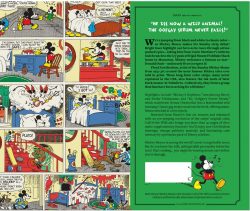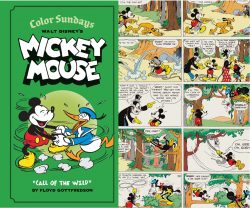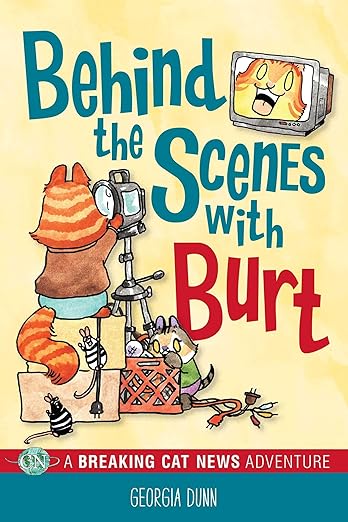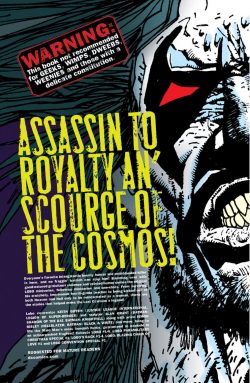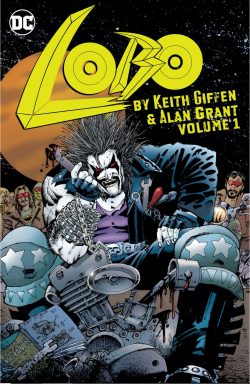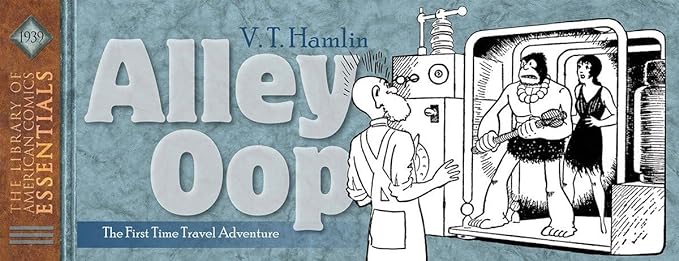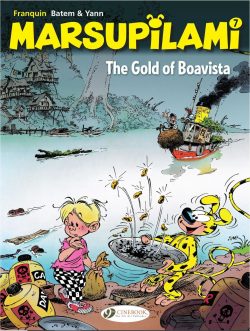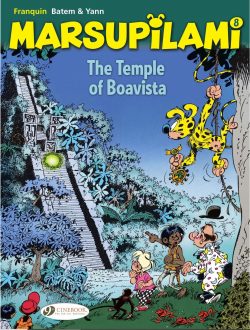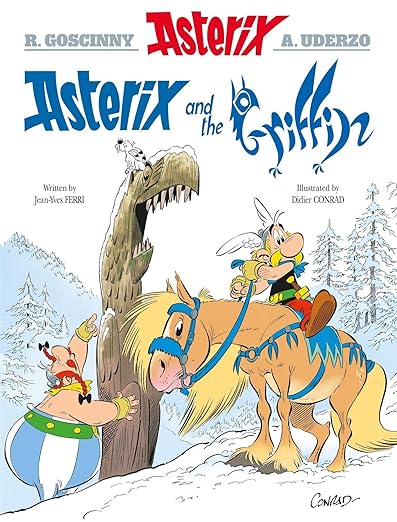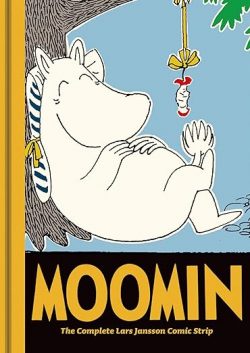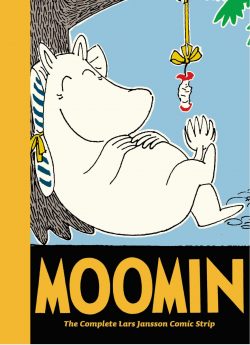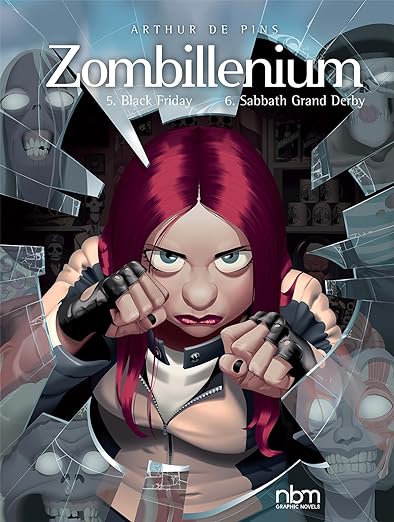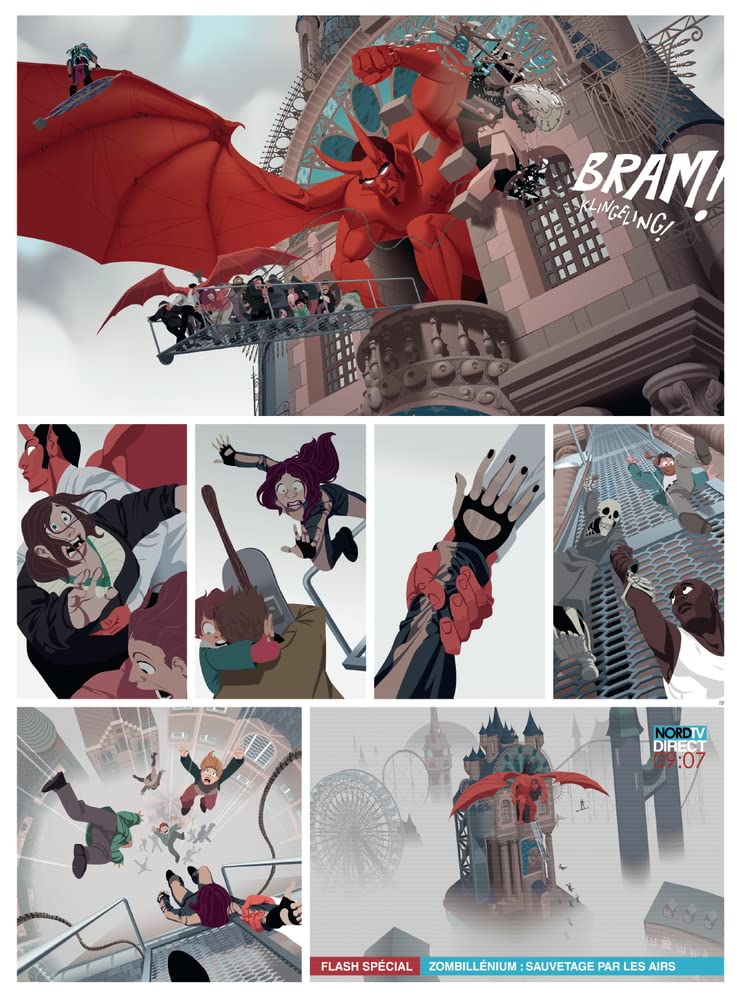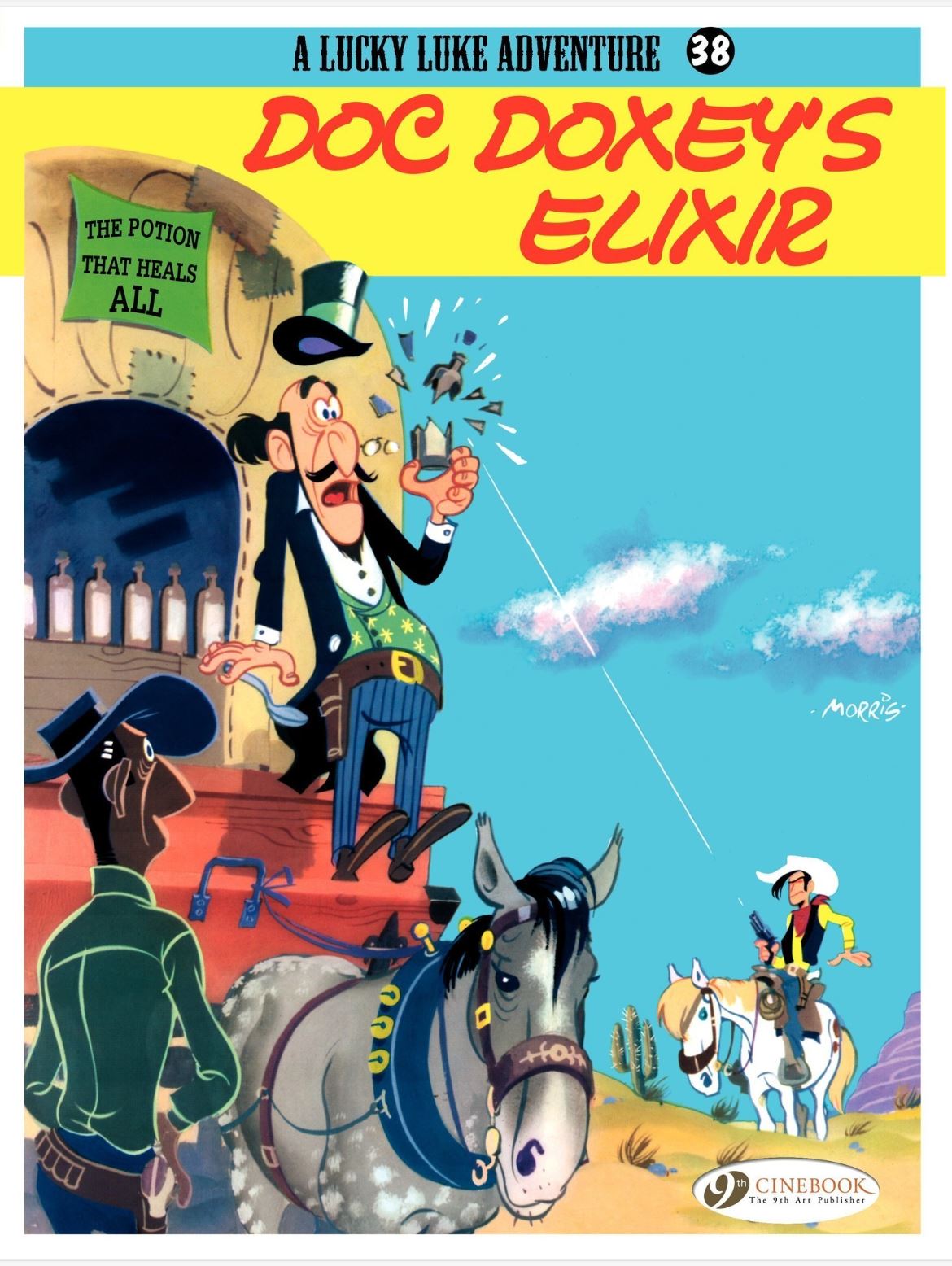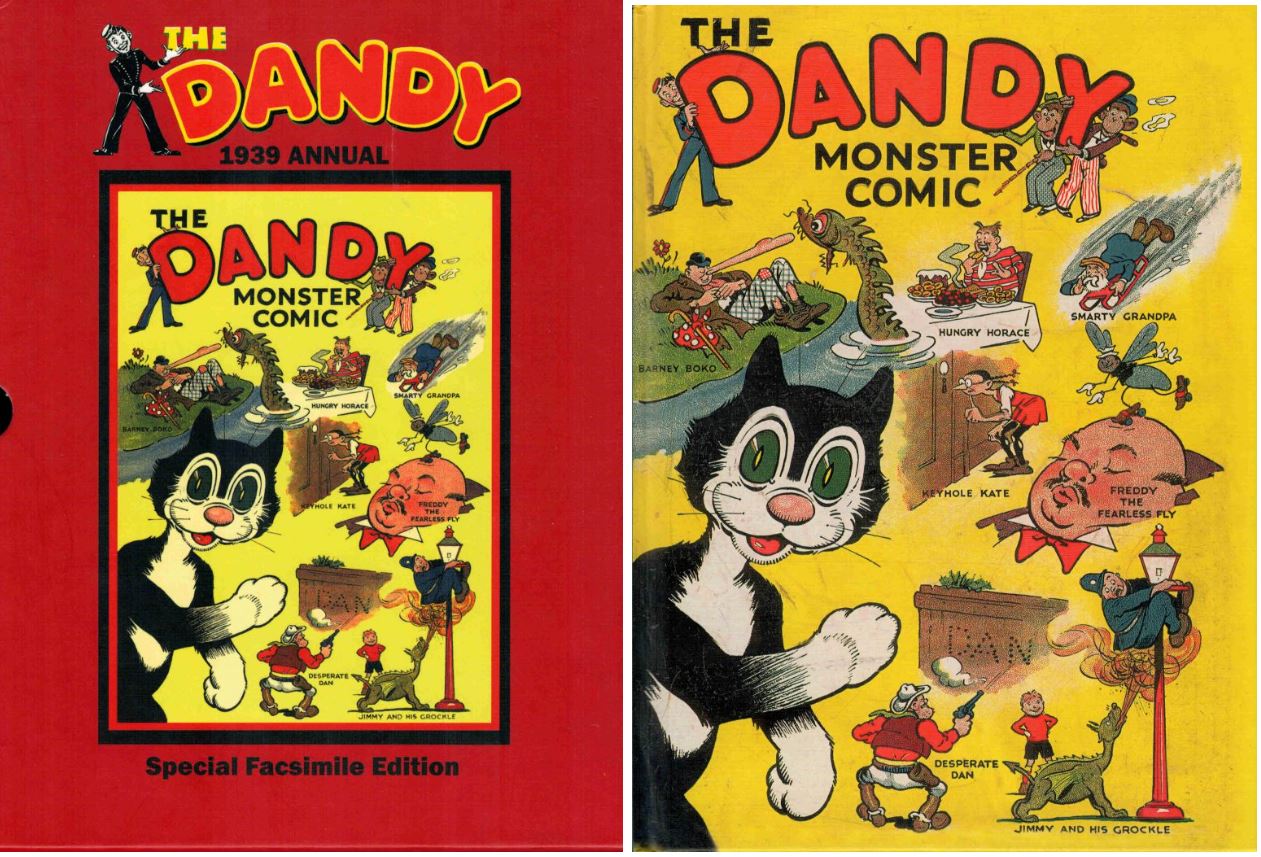
By Many and various (DC Thomson & Co/Aurum Press)
ISBN: 978-1- 84513-217-0 (Boxed slipcase HB)
This one’s actually older than me – at least in its original incarnation – and a true anniversary wonder.
Until it folded and was reborn as a digital publication on 4th December 2012, The Dandy was the third longest running comic in the world (behind Italy’s Il Giornalino – launched in 1924 – and America’s Detective Comics in March 1937).
Premiering on December 4th 1937, The Dandy broke the mould of British predecessors by using word balloons and captions rather than narrative blocks of text under sequential picture frames. A colossal success, it was followed eight months later (on July 30th 1938) by The Beano, and together they revolutionised the way children’s publications looked and, most importantly, how they were read.
Over the decades the “terrible twins” spawned a bevy of unforgettable, beloved household names who delighted generations of avidly devoted readers, and end of year celebrations were graced with bumper bonanzas of the weekly stars in extended stories in magnificent hardback annuals. As WWII progressed, rationed paper and ink forced the “children’s papers” into an alternating fortnightly schedule: on September 6th 1941 only The Dandy was published. A week later just The Beano appeared. They only returned to normal weekly editions on 30th July 1949…
However, as of this grand festive feast that’s all in the future. Here, masterfully restored, is a treasure trove of joyous pranks and all-ages adventure to delight and enthral. It should be noted however, that all this buffoonery and jolly japery was crafted at a time socially far-removed from ours, and there are terms and racial depictions that wouldn’t be given houseroom in today’s world. That was then, this is now, and that’s another thing you can be grateful for…
It opens in classis DCT manner with the entire cast chowing down to a monumental feast – a staple reward of those leaner, impoverished times – before James Crichton’s ‘Korky the Cat’ kicks things off with spot of calamitous dockside fishing, after which ‘Jimmy and his Grockle’ – a kind of Doberman dragon – foil a dognapping ring. Illustrated by James Clark, the strip was recycled from prose “Boys Paper” The Rover where it was “Jimmy Johnson’s Grockle” (1932).
Most pages come with riddles, jokes or single panel gags and many of the strips are delivered in the signature two colour process that typifies British Annuals and as usual no writers are named and precious few of the artists are credited. As always, I’ve offered a best guess as to whom we should thank, and of course I would be so very happy if anybody could confirm or deny my suppositions…
Prolific Allan Morley details how ‘Keyhole Kate’ falls foul of a burglar and cowboy superman, ‘Desperate Dan’ – by key man Dudley D. Watkins – braves harsh winter climes, before Morley’s ‘Freddy the Fearless Fly’ thwarts a human bully and thrashes a predatory spider.
These colossal tomes were all about variety and value for money and next up is a heavily-illustrated prose story detailing the feudal adventure of young shepherd-boy Gingan’s dragon-slaying quest with magical weapon ‘The Sword of Crad’ before wandering tramp ‘Barney Boko’ comes a-cropper after defacing public property in a wordless strip from John R. Mason.
As depicted by the superb Eric Roberts, ‘Podge’s Frame-Up’ sees the junior entrepreneur confusing art galleries with glaziers whilst nattily-dressed ‘Archie the Ape’ deals with a hungry lion and ‘Smarty Grandpa’ (by Watkins and a double for strip veteran Pa Broon) has a racially-charged moment at a minstrel show before anthropomorphic tortoise ‘Dan the Night-watchman’ confronts a gang of thieving rats…
‘The Boy that Beat the Band’ is another prose drama (illustrated by Fred Sturrock?) with a young orphan acrobat saving a disabled boy and thereafter rewarded with his heart’s desire – a job – after which Jack Glass’ text-block & pic strip ‘The Daring Deeds of Buck Wilson’ sees the singing cowboy battling kidnappers before the animal antics in ‘Bamboo Town’ find daring duo Bongo and Pongo organising a therapeutic gymnasium in a typically busy romp limned by Charlie Gordon.
Sam Fair’s ‘Wig and Wam the Skookum Kids’ were prank-playing “Red Indian” lads who here trick the Big Chief into baiting a bear before ‘Flippy the Sea Serpent’ – by Frank Minnitt – settles the hash of a snooty octopus whilst Smarty Grandpa fails to steal a pie…
Boneless Bill was a long-running but sadly anonymous strip starring an affable contortionist. Here he astounds an army recruiting officer before ‘Marmaduke Mean the Miser’ pays painfully for stealing a little lad’s Dandy comic. Then ‘Hungry Horace’ (Morley) finds his appetite briefly diminished after illicitly tapping the wrong barrel and a cunning old codger prevents a mugging in ‘Old Beaver’s Brainwaves’.
‘Wee Tusky’ was a long-running prose feature and here the baby elephant’s propensity for trouble leads to deadly danger but secures him a human friend in the end, after which Roberts’ ‘Helpful Henry’ adjusts seating arrangements despite a history of calamitous consequences, just as pompous (idiot) detective ‘Trackem Down’ botches another “case”…
Korky the Cat masters the fundamentals of golf whilst Jimmy and his Grockle find fun – and bananas – at the docks, after which Keyhole Kate’s snooping drenches a helpful bystander and Desperate Dan proves building sites can be dangerous places… for other people…
After another get-rich-quick scheme from Podge, sausage-snaffling ‘Dipper the Dodger’ falls foul of the law. Probably drawn by James Jewell, Dipper is a dead ringer for Beano and The People’s Journal cartoon stalwart Wee Peem (“He’s a Proper Scream”), so there might have been some cross-pollination back then.
Freddy the Fearless Fly turns arsonist to escape a spider’s trap before Helpful Henry learns the perils of electricity, and Jimmy Denton tries rodeo riding to save the ranch with the invaluable assistance of ‘White Star’s Star Turn’, in a prose thriller that seamlessly segues to Podge setting up his own postal service whilst ‘Bobby, the Boy Scout’ goes too far in his scheme to help a hobo…
Boneless Bill artfully apprehends a thief and Archie the Ape find busking hazardous to health, whilst Hungry Horace loses his lunch to a quick-witted sprinter, but savvy navies ‘Nick & Nack’ find a smart way to keep the cops from confiscating their grub.
Interfering busybodies Bobby, the Boy Scout and Helpful Henry both get it wrong again, after which we head west to see Wig and Wam the Skookum Kids prank their dad yet again even as Desperate Dan falls asleep in the park but still causes chaos…
‘Willing Willie and his Pa’ experience decorating woes before we revisit the days of the Raj in prose thriller ‘Pam the Peace-Maker’ wherein a little girl prevents an outbreak of war after which Helpful Henry confuses radio and electric irons and Korky triumphs over a tiger when he goes on safari.
Jimmy and his Grockle clash violently with shopkeepers and Old Beaver’s Brainwaves sees the gamey geezer getting back at the thug who pinched his job as itinerant Barney Boko pays through the nose for watching football without a ticket.
Dipper the Dodger meets a theatrical strongman and the Bamboo-Town boys convene a swimming class that would certainly have benefitted ‘Sandy Starfish, the Shipwrecked Sailor’ before Fred Sturrock illustrates a prose battle of wits between stubborn old men in ‘The House that Jack the Joker Built’.
More musical mayhem from Archie the Ape precedes Hungry Horace outwitting municipal bylaws in search of a big scoff, even as Podge dupes another crowd of sensation hungry oafs and Helpful Henry wrecks a house before it’s even built: a trick even Desperate Dan can’t match, even if he wasn’t so thirsty…
Mini vignettes for Podge, Barney Boko and Boneless Bill presage a riotous schoolboy romp in prose – probably illustrated by George Ramsbottom – that I need you to be grown up about. ‘Invisible Dick Spoofs the Spoofer’ is a smart tale from a venerable feature that ran in The Rover for years and when he turns the tables on a cruel stage magician humiliating his school chums you should be proud and not titter or snigger…
A rapid-fire tranche of cartoon antics, starring Bobby the Boy Scout, Podge, Marmaduke Mean the Miser, Flippy the Sea Serpent, Boneless Bill and Willing Willie and his Pa, lead to another text tale as animal-raised orphan ‘Buffalo Boy’ discovers toffee and begins his slow march back to civilisation…
From here it’s cartoon strip all the way with Korky, Keyhole Kate, Freddy the Fearless Fly, Helpful Henry, Wig and Wam the Skookum Kids, Smarty Grandpa and Dipper the Dodger all doing what they do best before Bamboo-Town brings down the curtain when Bongo and Pongo build an all-animal skating rink…
A marvel of nostalgia and timeless comics wonder, the true magic of this facsimile edition is the brilliant art and stories by a host of talents that have literally made Britons who they are today, and bravo to DC Thomson for letting them out for a half-day to run amok once again.
The DANDY is a trademark of and © D. C. Thomson & Co. Ltd. 2006. Associated characters, text and artwork © D. C. Thomson & Co. Ltd. 2006. All rights reserved.

